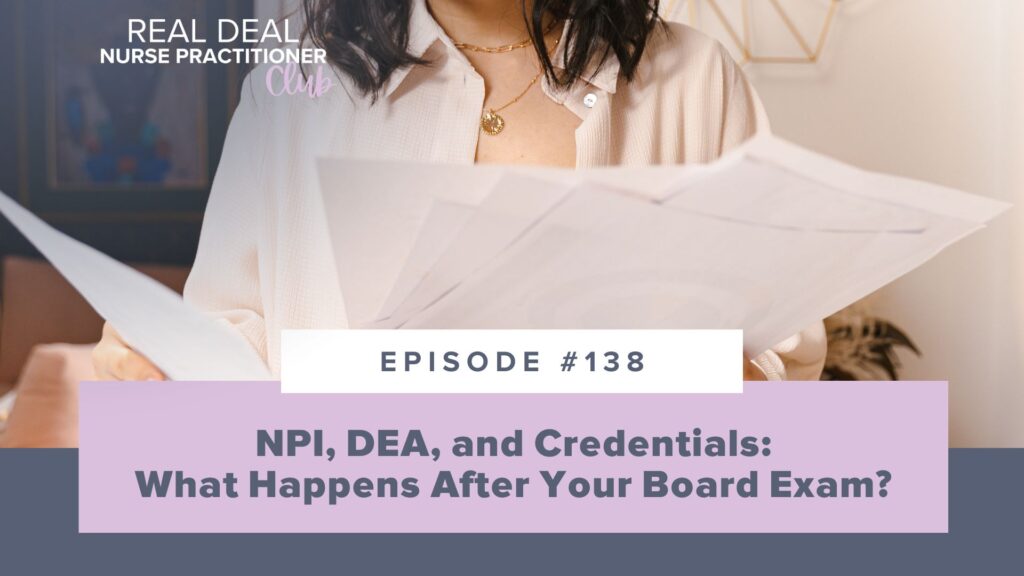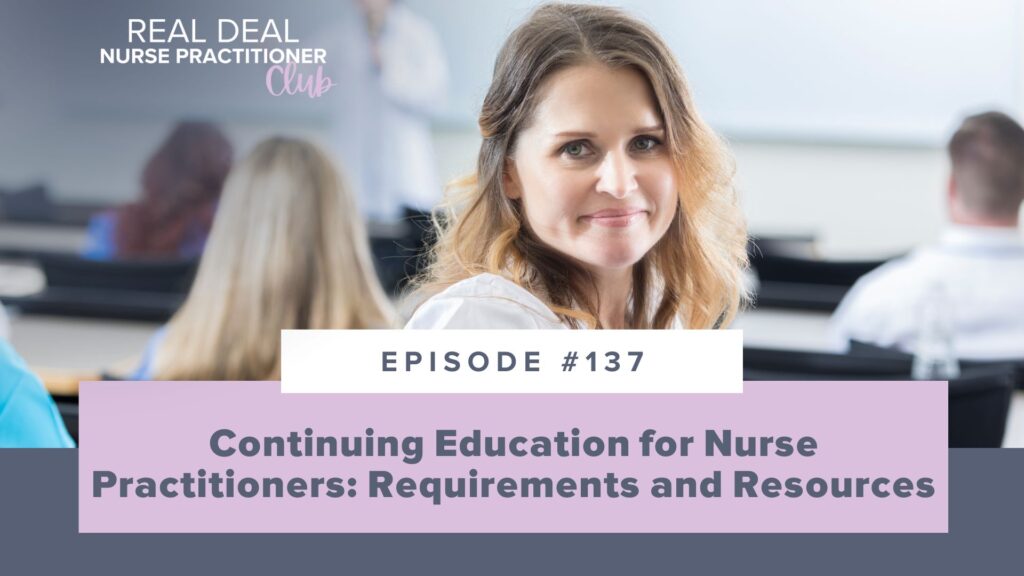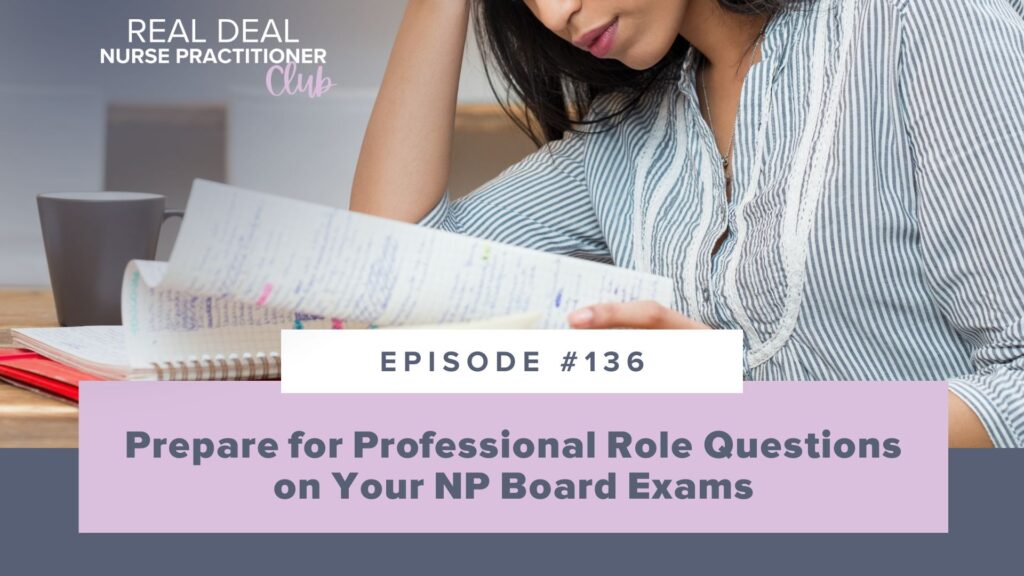Ep #117: When Patient Vignettes Reveal Hidden Challenges
- by Sarah Michelle
- Jul 10, 2024
- Podcasts

What You Will Discover:
- Lessons learned from two different patient vignettes.
- The importance of not taking one lab result at face value.
- Why you must consider other differentials if your patient isn’t seeing improvements.
- What the discovery process looked like in both of these patient cases.
Featured on the Show
Full Episode Transcript:

Welcome to the Real Deal NP Club. Whether you’re hoping to become a real deal nurse practitioner or you already are one, this is the place for you to get the resources you need as you tackle this massive transition into practice. We’re your hosts, Sarah Michelle, Chief Nursing Officer of Blueprint Test Prep, and Anna Miller, Director of Nursing Content. And we’re here to hang out with you each week like your best friends in the NP space. Let’s dive in.
Sarah: Hey y’all, we’re doing something new today that we have not done on the podcast before. But this new thing that we’re doing also comes with a disclaimer.
So we’re going through a patient vignette and so we’re going to be talking about some interesting cases we’ve seen from our own clinical practice or those around us. And of course with these cases they have all been modified to maintain that patient confidentiality, but we know that they can teach us something and it can help us to be better clinicians to kind of walk through these scenarios.
With that being said, we do not want any of this to be misconstrued as medical advice. You are a provider on your own, you make your own decisions, you follow the guidelines that you have available to you. And so we just like throwing the medical advice disclaimer right from the very beginning.
But it will be an interesting case to learn from and the theme of the vignettes today is endocrine, which I know can be a little bit intimidating, but we’ve got you, we’ve got your back. And of course, Anna is here and she’s going to share a story as well.
Anna: Yeah, and really I just want you all to think of this as like a cool, little bit of different approach to highlighting important clinical practice just overall concepts. Because I really enjoy, and I find students really enjoy making those connections to maybe what you’re learning in school, what you’re seeing in your clinical rotation and applying those to real life clinical scenarios.
And so we’ve actually got two stories for you today.
Sarah: Yeah, and I feel like for me, when I was a nurse practitioner student, that was when I really absorbed the information that I was learning, was when I saw it in a real life scenario. So these can be really invaluable learning tools.
Anna: Yeah, and just always remember that disclaimer that the exam and the textbook answer is always slightly different than real life. So this is kind of helping you blend it into real life.
Sarah: Absolutely. So for the first case, we’re going to set the stage here by the fact that we’re caring for a 62-year-old female in a primary care office. She’s been seen for multiple visits in the last few years for fatigue, then weight loss, then fatigue again.
Now, the weight loss had been unintentional, it was usually around 10 to 15 pounds and was accompanied by other symptoms of feeling stressed and anxious, having a little bit of difficulty with sleep. And then when she would have periods of fatigue, she just felt really run down for no particular reason. And it was bothersome for her because she was a really active person. She helped watch her grandkids a lot.
And so Anna, just with this initial info, what are some of your thoughts going on?
Anna: Well, I mean, we have a little bit of a hint here that it’s endocrine, but even without that, I’m definitely thinking something with the thyroid based on those symptoms.
Now that cycling back and forth that you mentioned, it does seem a little unusual from what I learned in school, because the patient seems to be having symptoms of both hyper and hypothyroidism, right? Like the hyper thyroid symptoms would be anxiety and weight loss. And then the hypothyroidism main symptom was that fatigue.
So I at least want to start and do a thyroid screening with that TSH level. And of course, of course, get a thorough medical history and physical exam first.
Sarah: Exactly. We definitely want to make sure that we’re being really thorough here, especially because the patient keeps coming back with the same cycle of symptoms over and over. And we really want to figure out the cause so she can start feeling better.
In terms of history, she really was quite healthy. She did not take any routine medication. She had no recent illnesses. She didn’t really know a lot about her family history other than that her mother died of complications from heart failure and her father died from lung cancer. But important to note too, she was not a smoker and she admitted to only occasional social alcohol use.
Anna: All right. And did anything else stand out in the review of symptoms or like the physical exam?
Sarah: Unfortunately, not really. The exam was quite normal and she denied any of the serious symptoms we’d look for like palpitations, chest pain, shortness of breath, those sorts of things.
Anna: So we talked about thyroid, but I can think of maybe another lab or two. So what labs did you end up ordering here?
Sarah: Yeah. Like you said, the main focus here was thyroid. So we got that TSH screening. But to be thorough, because we’re having this cycle of symptoms, we did get a CBC to rule out anemia and infection. And ordered a comprehensive metabolic panel to check that renal and liver function as well.
And so a few days later, we get the results back and I’m a little bit stumped because all the results were normal, which we think would be a good thing, but it doesn’t really help the patient get to the bottom of their symptoms either. So it kind of felt like a sucky thing too.
Anna: Yep, and this is where you hit that real life practice. So what next?
Sarah: Well, in the electronic medical record that I was using at the time, I was able to kind of view the trends in her lab data. And since this patient had presented to multiple providers over the past few years, who all had that same idea to check her thyroid, I decided to look at trends for her TSH values.
And I noticed something really interesting. The TSH values bounced up and down between low normal and high normal, low normal and high normal. And so they were really borderline results in either direction. But when she presented with hyperthyroidism symptoms, her TSH would be low normal. And then when she had increased fatigue, that TSH would be elevated.
Anna: That is so interesting. And so what management plan did you come up with for this?
Sarah: Well, it might’ve been a little bit unconventional, but I actually referred the patient with a normal TSH to endocrinology because she really needed a workup beyond my expertise. And I just felt like there was something more to her thyroid function than what was showing up.
And actually when she got the endocrinology, they ordered that thyroid antibody, some autoimmune tests, and the patient was ultimately diagnosed with Hashimoto thyroiditis. And so there really was an issue with her thyroid.
Anna: Wow, that’s amazing. So really what it boiled down to, right, was just listening to your patient, which is huge and not just taking one lab value at its face value. And just really taking those concerns seriously and following through until you get answers.
That is such a big lesson to take away as nurse practitioners, right? We are called to serve our patients and we have to believe them and we cannot lose sight of that.
Sarah: It would have been really easy to write her off. And another lesson I took away from this was to really listen to my gut and look at those trends. Not all conditions present with those isolated abnormalities. And a lot of times we might review trends to monitor disease progression, but it can also be used for that diagnostic workup too.
Anna: Yeah, I love that. And again, remember, your exam, if you are studying for that, is not going to get into these nitty gritty case scenarios, but it’s a really good way to just bridge the gap between practice. And that was a really excellent case, Sarah.
Sarah: Yeah, the exam likes black and white, always.
Anna: The exam loves black and white, which is why we’re like, “Oh, let’s order thyroid.” But then it comes back normal and it just shows such a different side of things of what it’s like in real life.
Now, for the case I’m going to share, it is about a 10 year old girl who came in for an acute visit. So she was reporting mouth pain for about a week or so, but her mother who was with her was also really concerned about weight loss that she had noticed. And the mom was reporting at least a 10 pound weight loss in less than a month.
Sarah: All right, well, I’ve already got a couple of thoughts, but what were your initial thoughts with this case?
Anna: You know, initially I was not too concerned, right? I was familiar with the patient and her last well child exam was about three to four months prior and was normal, right? She didn’t appear too thin or otherwise ill, so my main focus was on that mouth pain. And I also thought that some of that weight loss could be attributed to decreased intake due to the mouth pain, right?
Now, of course I did ask about nutrition and diet and the mother confirmed that she was eating a little bit less lately, but otherwise no major changes in her diet.
Sarah: All right, well you’re already starting to rule out some things I’m thinking. So did the exam show anything interesting?
Anna: Well, during the exam, I noted thrush in her mouth. So I identified the reason for the mouth pain. And I was happy to be able to get that fixed for her, and prescribe some nystatin. And I did encourage the patient to follow up if the thrush didn’t resolve or if the concerns about her weight continued.
And of course, in real life it is never that simple. And the patient ended up coming back about two weeks later. Now, good news is that the thrush had resolved, but the weight loss hadn’t and she had actually lost even more weight. So at this point, I am concerned.
So what are you thinking here? You said you’ve had some thoughts.
Sarah: Well, if it’s not a nutritional issue and her diet is adequate to support her having a healthy weight, then that makes me think, okay, maybe this is a metabolic issue, an absorption issue. So I would definitely want to go down the route of asking about GI symptoms like vomiting, diarrhea.
But then I’m also thinking too, and this might be off base, but some signs of diabetes as well. Like the three Ps, polyuria, polydipsia, and polyphagia.
Anna: Yeah, no, you are not off base. You are spot on. That is exactly what I started thinking as well. And so after some further questioning, the patient did admit to polyuria and polydipsia. And so I definitely started leaning towards diabetes. And if the patient is already experiencing weight loss, then her blood sugar has been elevated for a really long time at this point.
So we checked a random blood glucose in the office and it came back literally greater than 250. Yeah. So immediately we sent her to the emergency department where her blood glucose was reported at 323. So she was admitted to the hospital where her blood sugar was stabilized and pediatric endocrinology took over that diabetic management.
Sarah: Yeah, that’s a really incredible pickup to get because you’re like, it presents weird, you know? Like you’re so focused on the thrush, fixing the thrush. And then it’s like, oh wait, she’s still losing weight. So that one is definitely pretty tricky.
Many times people with type one diabetes are diagnosed when they develop that diabetic ketoacidosis or even worse, they end up in a diabetic coma. And the symptoms in the beginning can be really insidious. But I think the big clue here that really gave it away was the weight loss.
Normally insulin is secreted when the blood glucose rises. And in type one diabetes, the loss of those pancreatic beta cells leads to that insufficient production of insulin. And so there’s not enough insulin around anymore to allow glucose into the cells. And because of that, the body feels starved of energy and it starts to utilize those fat stores and then eventually that muscle mass for conversion into energy. And that really can cause some significant weight loss.
Anna: Yeah, it’s a whole cascade. And really looking back now, the oral thrush infection was another clue, right? The patient’s elevated glucose levels placed her at risk for the fungal infection. And the great news is that the patient is doing well, adjusting to the new lifestyle with diabetes. And besides the just interesting clinical reasoning that happened in this case, I think the other lesson here is that we need to keep an open mind, right?
If a patient returns for follow-up without improvement, you have to consider other differentials.
Sarah: Yeah, I think that was like the general theme of both our stories. Like we’ve got people that are having a cycle of symptoms that are coming back and coming back. And so what can we do to better serve those patients?
And I really hope that you all enjoyed this different style of episode. I’m imagining that you guys are really going to like this and you’re going to ask for it a lot more and we’re going to do some different themes of patient vignettes as well and talk about just some more helpful lessons along the way.
Anna: Yeah, I really liked this episode too. This was really fun to share a couple of cases and I learned a ton just listening to your story, Sarah. And it’s nice to know that at least these two cases had a happy ending.
Sarah: Yeah, and thanks for sharing your story as well. So thanks to everyone for tuning in. We hope you enjoyed this episode and be sure to follow us wherever you stream your podcast or SMNP Reviews on YouTube and Facebook, but we’ll be talking to you in a couple of weeks.
As an extra bonus friends, if you’re looking for support no matter what phase of your nurse practitioner journey that you’re currently in, I have communities available for both students and new nurse practitioners. In these communities, we work to uplift one another and grow this profession together every single day. Links to join will be included for you in the show notes.
Thanks for listening to the Real Deal Nurse Practitioner Club. If you want more information about the different types of support that we offer to students and new nurse practitioners, you can visit npreviews, with an S, dot com. We’ll see you next week.
Enjoy the Show?
- Don’t miss an episode: follow the podcast on Spotify, Apple Podcasts or RSS.
Related Posts
Search the Blog
Prepping for Primary Care NP Boards?
Join our Primary Care Live Study Group or check out the Self-Paced Courses & Qbank options!
Learn MoreExplore Specialty NP Qbanks & Mock Exams
Practice with board-style questions for your AGACNP, PMHNP, ENP, WHNP, or PNP exams.
Get StartedJoin our Facebook Group!
Get FREE support and encouragement from thousands of FNP/AGPCNP students and our NP support team.
Join the CommunitySign Up for Free Live Classes
Join us for FREE monthly live study sessions covering topics such as antibiotics, diabetes, musculoskeletal conditions, depression & anxiety, and more!
Grab a Spot


